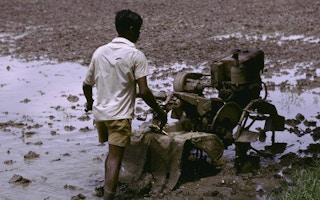The World Meteorological Organization branded 2001-2010 as “a decade of climate extremes”. Over that decade, the yearly average number of severe storms with ‘names’ was 25 per cent more than the average of 1981-2010. This surely indicates a severe decade ahead of us.
The United Nations’ Global Assessment Report on Disaster Risk Reduction (GAR) 2013 adds further to our worry. It estimates that at least 50 percent of the direct financial losses are from smaller disasters taking place at the country level and is not counted in the global calculations.
If our post-2015 efforts need to “put sustainable development at the core,” despite worrying pasts and uncertain futures, we must address climate change and disaster resilience. To do so, among other things, we need creative funding systems with practical actions at the country and global levels.
The least-developed, climate vulnerable countries are often seen waiting for money to come to help them. Bangladesh is a different picture, however. Between July 2009 and June 2013, its government has put about $315 million of its own money to the ‘Bangladesh Climate Change Trust Fund’. Until April 2013, more than 200 projects have been supported from this Trust Fund to implement the Bangladesh Climate Change Strategy and Action Plan (BCCSAP, 2009) to prepare the country against the impacts of climate change.
Bangladesh’s earlier efforts are also praiseworthy. The BCCSAP (2009) reads “Over the last three decades, the government has invested over $10 billion (at constant 2007 prices) to make the country more climate resilient and less vulnerable to natural disasters.” The report then goes on telling us in which areas this substantial investment, often supported by development partners, went.
Examples of major actions include building of flood embankments, cyclone and flood shelters and coastal polders, and protection of roads and highways. This makes Bangladesh a country with strength and vision to reduce its disaster and climate vulnerability.
Researchers, donors and government and non-governmental organisations mentioned this ‘$10 billion investment’ in many a report. But interestingly, these publications mentioned that this amount of investment was made over 30 to 50 years.
Common sense would say the investment had to be made since 1971 − the year Bangladesh got independence. But some reports indicate part of this investment as early as 1960.
Sometimes a single report mentions different timeframes. For example, the World Bank’s report of 2010 carries two different figures in four different places.
The BCCSAP is a milestone document. It represents the self-motivation of a highly climate-vulnerable country to organise itself face climate challenges. It, however, does not carry the primary source of this particular estimate.
The mention of ‘$10 billion investment’ in the development literature shows that we sometimes rush to refer to numbers. But because numbers can represent a country’s glorious past, future visions, commitments to the citizens or image before the world, we have to be careful using them.
Researchers need to mention the source of information to avoid plagiarism or intellectual theft. Non-academic writers also need to practice this. No one in his right mind wants to be blamed for spreading wrong numbers or creating new myths!
Haseeb Md. Irfanullah leads the disaster risk reduction and climate change programme of Practical Action in Bangladesh. This post originally appeared here.










